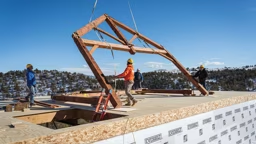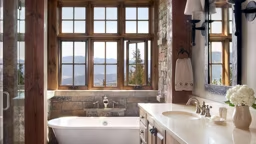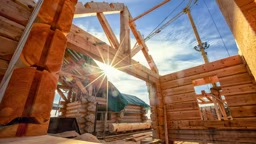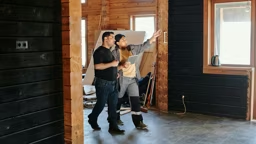Are you struggling to decide between a timber-framed home or a log cabin kit? What are the differences between them and how do you tell them apart? Both are built by skilled tradesmen, both use large, beautiful pieces of wood and both create very aesthetically pleasing homes. But there are a few key differences!
Here's a look at a few of the main distinctions, along with some of the similarities to help you decide which is the right build for you.
Structural Differences
One of the most obvious differences between a timber frame kit and a log home kit is the way they are built, and ultimately how they look once finished.

Photo: markjb / Adobe Stock
Log Homes
Log homes are easy to spot from the exterior, with large horizontal logs laid on top of each other to create the walls.
Timber Frame Homes
Timber frame homes, however, often look like conventional homes from the exterior but feature magnificent exposed wood in the interior to create eye-catching designs. Timber-framed homes use a historic building method that relies on a super-strong, interlocking frame to create a skeleton of vertical and horizontal beams which create the shell of the home.
Similarities
Both often share a few structural similarities such as open plan spaces, large cathedral ceilings, walls of windows, and fireplaces.Manufacturing Process
Both log and timber home kits are designed and built initially in a factory, and then transported in pieces to the plot of land which they’re going to be built on. The design phase normally takes a similar amount of time regardless of which building method you choose. This process can take anywhere from a few days if you’re just making minor changes to a pre existing floor plan, to a few weeks if you’re designing a kit from scratch. During the factory building process, generally a log home can be built quicker than a timber frame because there are less components involved. You can expect a log home to take anywhere from two to six weeks depending on the level of customization, and a timber frame kit usually takes months rather than weeks to manufacture.Price Comparison
Log homes are typically more expensive than timber frame homes. This is because a solid piece of log wall is more expensive than a wood joist and insulation. It can, however, be difficult to compare them like-for-like because while log cabins only require one piece of material to construct the walls, timber homes need a number of different components from joists, to insulation, to exterior and interior finishes. Ultimately the cost comes down to the level of quality of the build. You might find timber frame kits that are more expensive than a similarly sized log cabin kit, it really does depend on the company's expertise and the quality of the home.
Energy Efficiency
Again, it comes down to the individual build. Timber-framed homes are usually highly energy efficient due to the amount of insulation in the walls, ceiling and floor. They also offer plenty of flexibility in designing the house to be carbon neutral. Log homes usually only have insulation in the roof and floor, and so their energy efficiency depends on how well the logs are sealed and joined together. Log homes can be extremely energy efficient if built to a high standard.Durability and Stability

Photo: shonflare / pixabay.com
Log homes need time to settle as the logs adapt to the climate which it’s been built in. Logs can shrink and expand as they settle which in rare cases can lead to checking, cracking or warping. However, in a well-built and high quality cabin, you won’t see much of this. Timber frame homes are much less susceptible to the elements, and don’t shrink or expand as much as log homes.
The Fairbanks House (the oldest timber-framed house in America) and Nothnagle Log Cabin (the oldest log home) were built within a year of each other and are almost 400 years old. These stand as iconic reminders that as long as the home is well built, they are both long lasting and durable styles.
Customization
Both home types are usually completely customizable. If you want to change the floor plan in either, this can be done with the company you choose. The difference between these two styles though, is there is some more design flexibility with timber frame houses. With a log cabin, the walls that you see on the exterior help you to visualize what the inside will look like too and where the room divides are. Timber frames homes, on the other hand, can completely surprise you on the interior. The outside of timber-framed homes can be completely customized and finished in any way you desire. In fact, sometimes you might not even be able to tell a home is timber-framed just from looking at the outside. A few options include bricks, wood siding and stone.Interior

Photo: pixabay.com
Can’t Decide?
If you love wood, and have always dreamt of living in a wooden home, whichever one you choose is sure to offer you a great lifestyle. However, you can also always take the best of both worlds and create a hybrid cabin!
Author Bio: David Woods has worked with wood for his entire life. He has built many homes and owned a carpentry company for over twenty years. He set up Log Cabin Hub to share his knowledge back in 2015 and since then, has helped over two million people research their own log dream.











